Special Report
This Is How Many People Are Living With Cancer in Every State

Published:
Last Updated:

Cancer is the second leading cause of death worldwide. About 9.6 million people died from the disease last year, according to the World Health Organization — about one in every six deaths. In the United States, an estimated 610,000 people died from cancer in 2018, according to the American Cancer Society.
The rate of new cancer cases is expected to increase over the next few years, a trend that is mostly contributed to the fact that people live longer and the risk of developing the disease increases with age, according to Dr. Joseph Lynch, an oncologist from Geisinger, said. In other words, more people are now able to live longer with the illness. But more people also live longer with the illness.
24/7 Tempo reviewed how many people in every state live with cancer using data from the American Cancer Society. The organization identifies anyone who has had a history with the disease as a “survivor.” That includes anyone living with cancer, regardless of whether it has gone in remission.
While climbing cancer rates are discouraging, there is some good news. “Many types of cancer are increasingly becoming a chronic illness,” Lynch said. In other words, more people are now able to live longer with the illness. This is largely due to improved rates of early detection, especially when it comes to breast and colon cancer – two of the most common types of the condition – as well as increasingly effective treatment.
The median survival time — as in years people lived with cancer after being diagnosed — used to be three years, Lynch noted. “It’s now 10-12 years.”
The biggest milestone in cancer treatment, according to Lynch, is immunotherapies for solid tumors, the types that don’t contain cysts or liquid areas such as sarcomas or lymphomas. Quality of life for many patients with certain types of cancer has also improved due to various treatment options. For example, people living with multiple myeloma, a cancer that forms in the plasma cells, have a much better quality of life because they take their medication orally, Lynch explained. “Taking one pill a week instead of having to make time and change plans to go to the doctors’ office allows you to live your life as normally as possible,” he added. These are the states with the highest cancer rates.
Click here to see the number of people living with cancer in every state
To identify the number of cancer survivors in each state, 24/7 Tempo reviewed the most recent estimated number of cancer survivors as of Jan. 1, 2016 by state in the 2016-2017 “Cancer Treatment & Survivorship Facts & Figures,” published by the American Cancer Society. The estimated number of new cases and number of deaths in 2019, as well as incident and death rates for 2011-2015 and 2012-2016, respectively, is from the 2019 “Cancer Facts and Figures” also published by the American Cancer Society. Total population and data on adults with no health insurance is from the American Community Survey 2017 1-year estimates, and the annual unemployment rate for 2018 is from the Bureau of Labor Statistics.

1. Alabama
> Total population: 4,874,747 (24th highest)
> Number of people living with cancer as of 2016: 223,990 (25th highest)
> New cancer cases in 2019: 28,950 (23rd highest)
> Cancer deaths in 2019: 10,630 (22nd highest)
> Population with no health insurance: 9.4% (14th highest)
[in-text-ad]
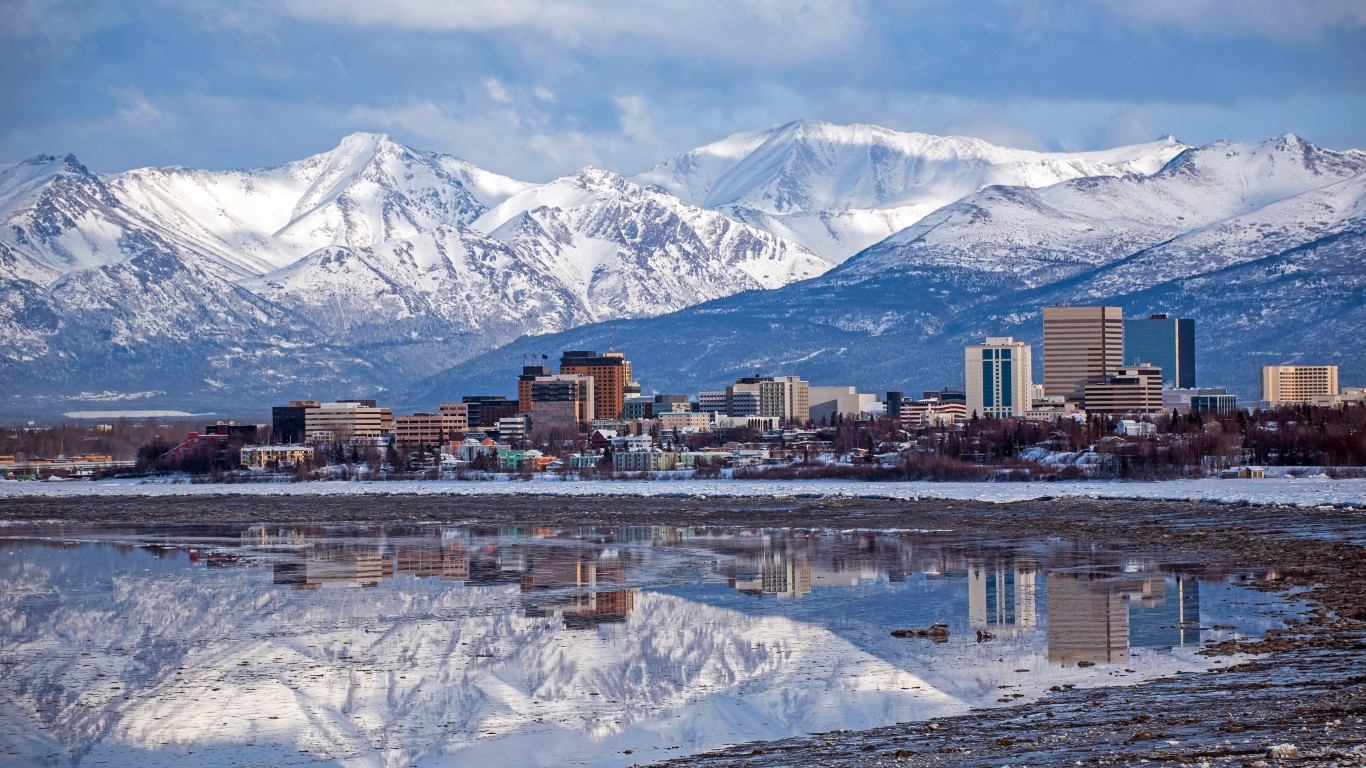
2. Alaska
> Total population: 739,795 (3rd lowest)
> Number of people living with cancer as of 2016: 33,340 (3rd lowest)
> New cancer cases in 2019: 3,090 (2nd lowest)
> Cancer deaths in 2019: 1,120 (2nd lowest)
> Population with no health insurance: 13.7% (3rd highest)

3. Arizona
> Total population: 7,016,270 (14th highest)
> Number of people living with cancer as of 2016: 354,530 (13th highest)
> New cancer cases in 2019: 37,490 (15th highest)
> Cancer deaths in 2019: 12,470 (17th highest)
> Population with no health insurance: 10.1% (11th highest)

4. Arkansas
> Total population: 3,004,279 (19th lowest)
> Number of people living with cancer as of 2016: 131,070 (19th lowest)
> New cancer cases in 2019: 16,580 (19th lowest)
> Cancer deaths in 2019: 6,800 (22nd lowest)
> Population with no health insurance: 7.9% (25th lowest)
[in-text-ad-2]

5. California
> Total population: 39,536,653 (the highest)
> Number of people living with cancer as of 2016: 1,734,870 (the highest)
> New cancer cases in 2019: 186,920 (the highest)
> Cancer deaths in 2019: 60,590 (the highest)
> Population with no health insurance: 7.2% (21st lowest)

6. Colorado
> Total population: 5,607,154 (21st highest)
> Number of people living with cancer as of 2016: 207,460 (24th lowest)
> New cancer cases in 2019: 26,800 (24th highest)
> Cancer deaths in 2019: 8,120 (23rd lowest)
> Population with no health insurance: 7.5% (23rd lowest)
[in-text-ad]

7. Connecticut
> Total population: 3,588,184 (22nd lowest)
> Number of people living with cancer as of 2016: 224,290 (24th highest)
> New cancer cases in 2019: 21,950 (23rd lowest)
> Cancer deaths in 2019: 6,470 (19th lowest)
> Population with no health insurance: 5.5% (12th lowest)

8. Delaware
> Total population: 961,939 (6th lowest)
> Number of people living with cancer as of 2016: 50,760 (6th lowest)
> New cancer cases in 2019: 5,870 (6th lowest)
> Cancer deaths in 2019: 2,140 (8th lowest)
> Population with no health insurance: 5.4% (10th lowest)

9. Florida
> Total population: 20,984,400 (3rd highest)
> Number of people living with cancer as of 2016: 342,590 (15th highest)
> New cancer cases in 2019: 131,470 (2nd highest)
> Cancer deaths in 2019: 45,000 (2nd highest)
> Population with no health insurance: 12.9% (5th highest)
[in-text-ad-2]

10. Georgia
> Total population: 10,429,379 (8th highest)
> Number of people living with cancer as of 2016: 410,740 (10th highest)
> New cancer cases in 2019: 50,450 (11th highest)
> Cancer deaths in 2019: 17,880 (10th highest)
> Population with no health insurance: 13.4% (4th highest)

11. Hawaii
> Total population: 1,427,538 (11th lowest)
> Number of people living with cancer as of 2016: 77,500 (11th lowest)
> New cancer cases in 2019: 7,120 (9th lowest)
> Cancer deaths in 2019: 2,560 (9th lowest)
> Population with no health insurance: 3.8% (2nd lowest)
[in-text-ad]

12. Idaho
> Total population: 1,716,943 (12th lowest)
> Number of people living with cancer as of 2016: 70,970 (9th lowest)
> New cancer cases in 2019: 8,390 (10th lowest)
> Cancer deaths in 2019: 3,040 (11th lowest)
> Population with no health insurance: 10.1% (11th highest)

13. Illinois
> Total population: 12,802,023 (6th highest)
> Number of people living with cancer as of 2016: 602,890 (5th highest)
> New cancer cases in 2019: 68,560 (6th highest)
> Cancer deaths in 2019: 24,410 (7th highest)
> Population with no health insurance: 6.8% (20th lowest)

14. Indiana
> Total population: 6,666,818 (17th highest)
> Number of people living with cancer as of 2016: 273,060 (20th highest)
> New cancer cases in 2019: 35,280 (18th highest)
> Cancer deaths in 2019: 13,690 (14th highest)
> Population with no health insurance: 8.2% (24th highest)
[in-text-ad-2]

15. Iowa
> Total population: 3,145,711 (21st lowest)
> Number of people living with cancer as of 2016: 172,030 (21st lowest)
> New cancer cases in 2019: 17,810 (21st lowest)
> Cancer deaths in 2019: 6,480 (20th lowest)
> Population with no health insurance: 4.7% (6th lowest)

16. Kansas
> Total population: 2,913,123 (16th lowest)
> Number of people living with cancer as of 2016: 139,660 (20th lowest)
> New cancer cases in 2019: 15,340 (18th lowest)
> Cancer deaths in 2019: 5,550 (18th lowest)
> Population with no health insurance: 8.7% (20th highest)
[in-text-ad]

17. Kentucky
> Total population: 4,454,189 (25th lowest)
> Number of people living with cancer as of 2016: 233,120 (23rd highest)
> New cancer cases in 2019: 26,400 (25th lowest)
> Cancer deaths in 2019: 10,580 (23rd highest)
> Population with no health insurance: 5.4% (10th lowest)
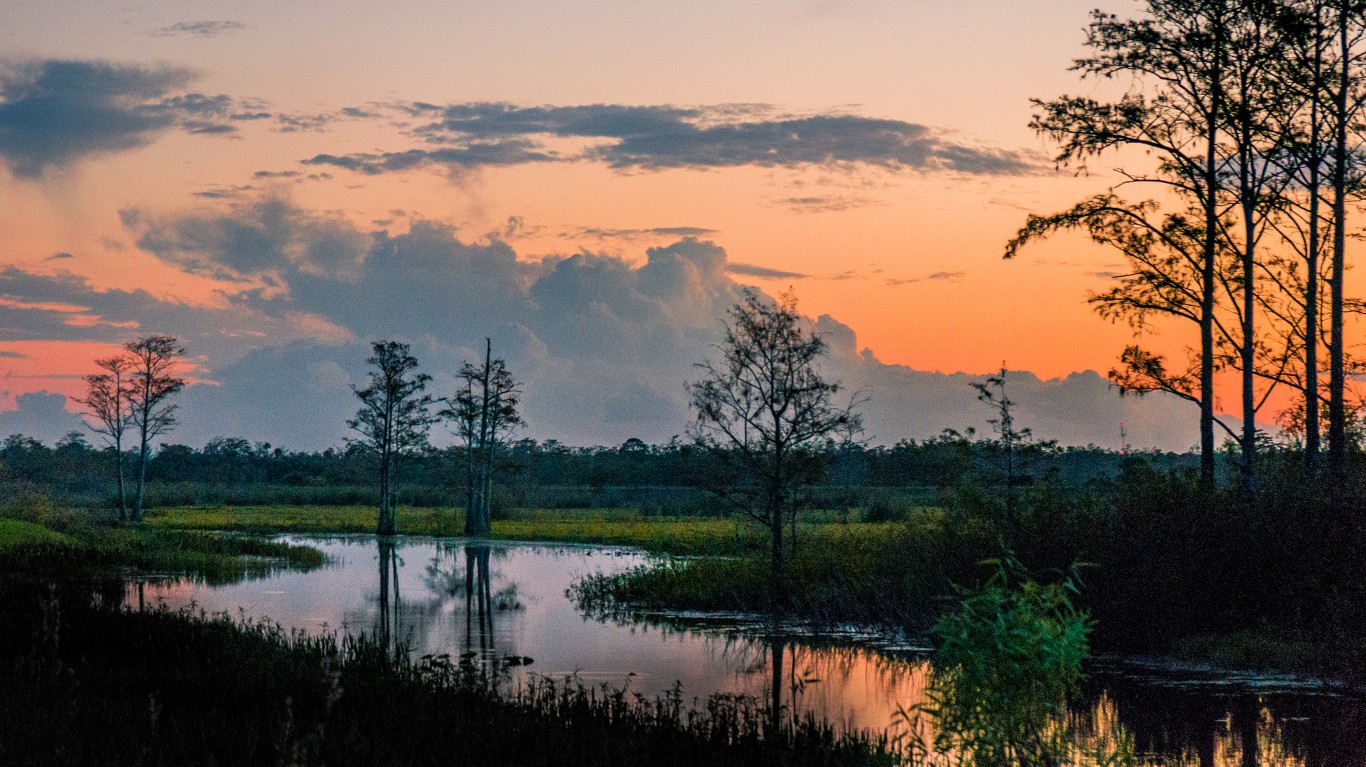
18. Louisiana
> Total population: 4,684,333 (25th highest)
> Number of people living with cancer as of 2016: 213,580 (25th lowest)
> New cancer cases in 2019: 26,800 (24th highest)
> Cancer deaths in 2019: 9,260 (25th highest)
> Population with no health insurance: 8.4% (22nd highest)

19. Maine
> Total population: 1,335,907 (9th lowest)
> Number of people living with cancer as of 2016: 87,630 (12th lowest)
> New cancer cases in 2019: 8,920 (12th lowest)
> Cancer deaths in 2019: 3,310 (13th lowest)
> Population with no health insurance: 8.1% (25th highest)
[in-text-ad-2]

20. Maryland
> Total population: 6,052,177 (19th highest)
> Number of people living with cancer as of 2016: 254,540 (22nd highest)
> New cancer cases in 2019: 33,140 (20th highest)
> Cancer deaths in 2019: 10,780 (20th highest)
> Population with no health insurance: 6.1% (18th lowest)
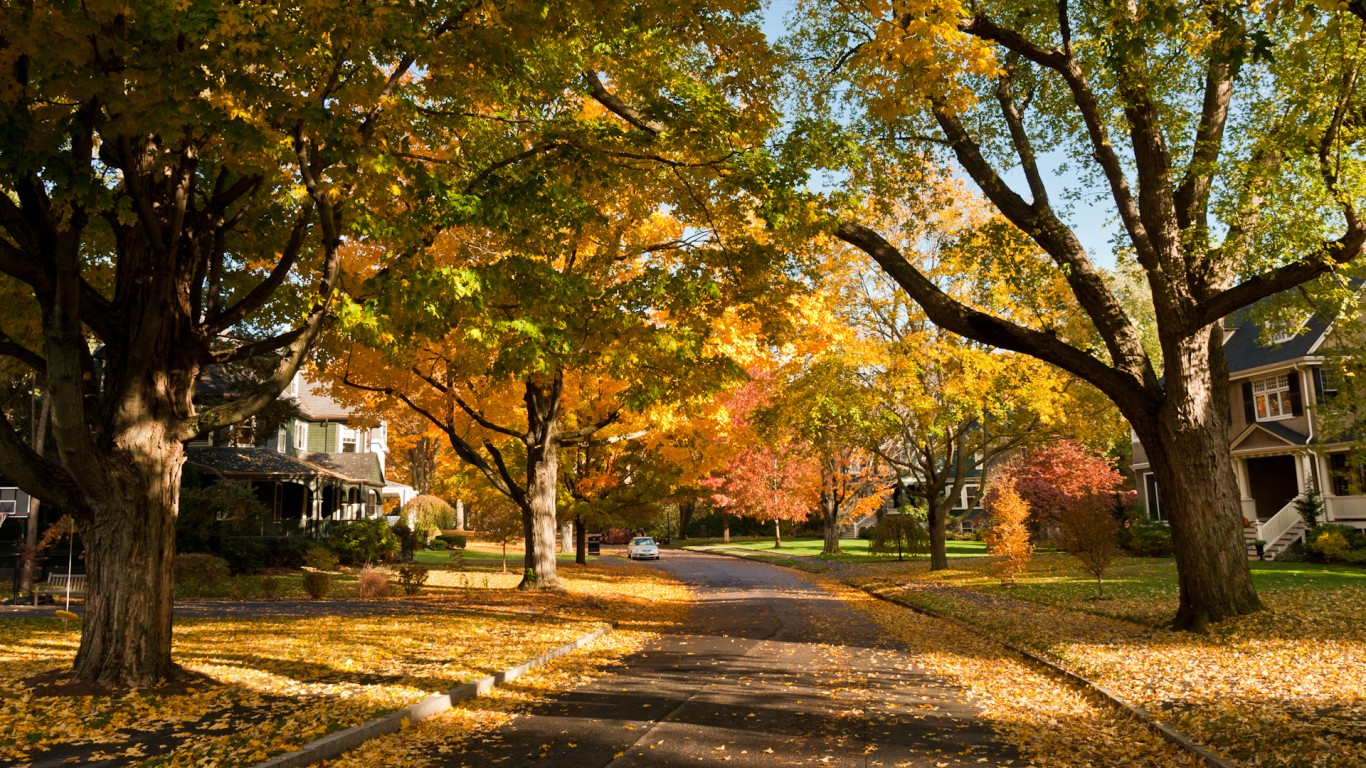
21. Massachusetts
> Total population: 6,859,819 (15th highest)
> Number of people living with cancer as of 2016: 402,930 (11th highest)
> New cancer cases in 2019: 40,020 (13th highest)
> Cancer deaths in 2019: 12,420 (18th highest)
> Population with no health insurance: 2.8% (the lowest)
[in-text-ad]
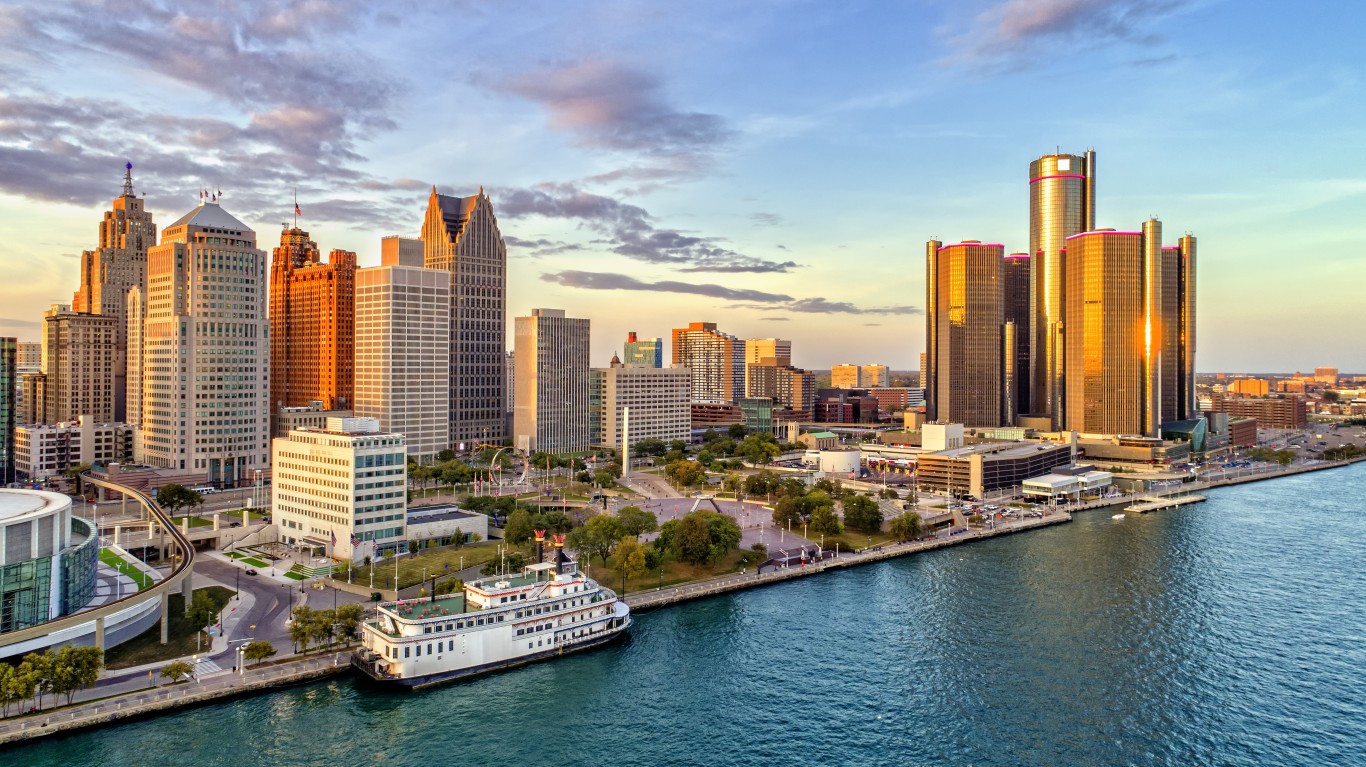
22. Michigan
> Total population: 9,962,311 (10th highest)
> Number of people living with cancer as of 2016: 526,100 (7th highest)
> New cancer cases in 2019: 58,360 (9th highest)
> Cancer deaths in 2019: 21,150 (8th highest)
> Population with no health insurance: 5.2% (7th lowest)

23. Minnesota
> Total population: 5,576,606 (22nd highest)
> Number of people living with cancer as of 2016: 276,770 (18th highest)
> New cancer cases in 2019: 30,560 (21st highest)
> Cancer deaths in 2019: 10,020 (24th highest)
> Population with no health insurance: 4.4% (3rd lowest)

24. Mississippi
> Total population: 2,984,100 (17th lowest)
> Number of people living with cancer as of 2016: 123,580 (18th lowest)
> New cancer cases in 2019: 17,050 (20th lowest)
> Cancer deaths in 2019: 6,720 (21st lowest)
> Population with no health insurance: 12.0% (7th highest)
[in-text-ad-2]

25. Missouri
> Total population: 6,113,532 (18th highest)
> Number of people living with cancer as of 2016: 275,980 (19th highest)
> New cancer cases in 2019: 35,480 (17th highest)
> Cancer deaths in 2019: 13,080 (15th highest)
> Population with no health insurance: 9.1% (16th highest)
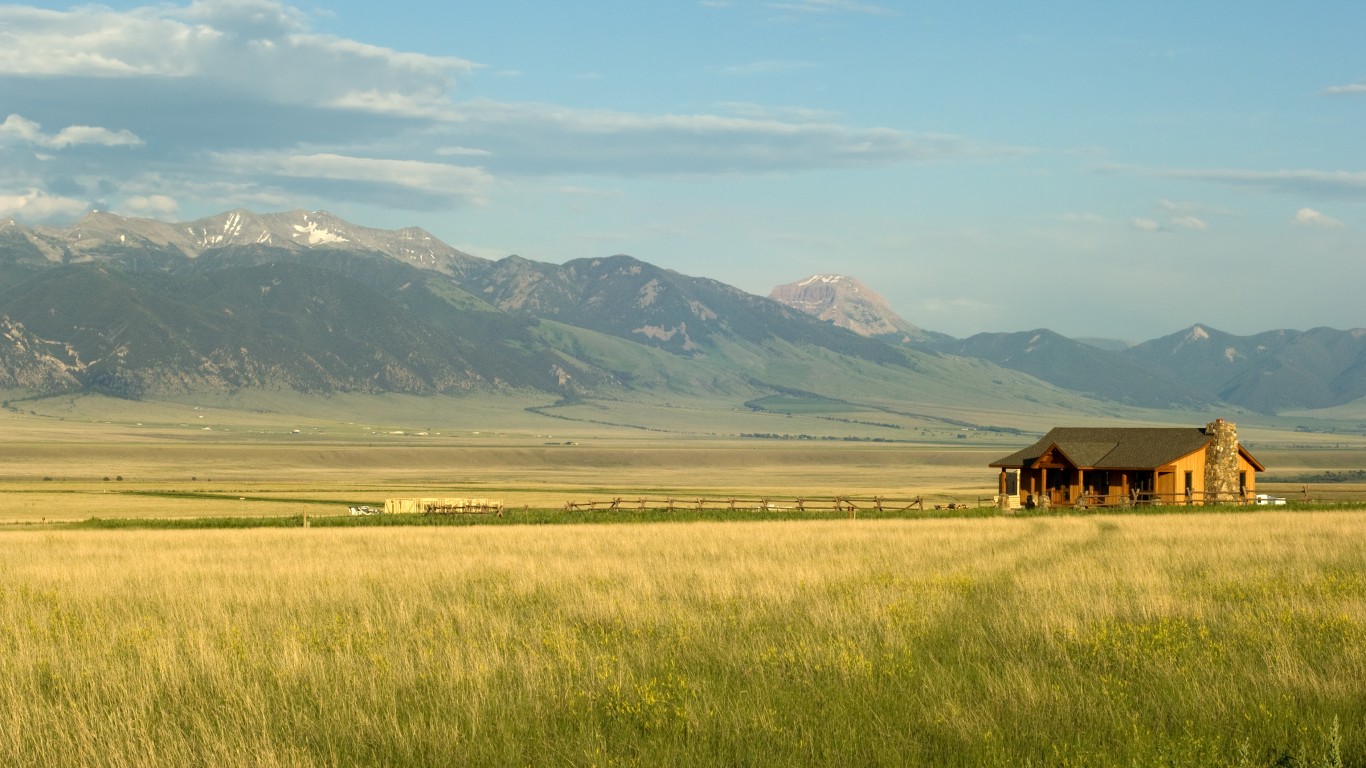
26. Montana
> Total population: 1,050,493 (7th lowest)
> Number of people living with cancer as of 2016: 54,850 (7th lowest)
> New cancer cases in 2019: 5,920 (7th lowest)
> Cancer deaths in 2019: 2,100 (6th lowest)
> Population with no health insurance: 8.5% (21st highest)
[in-text-ad]
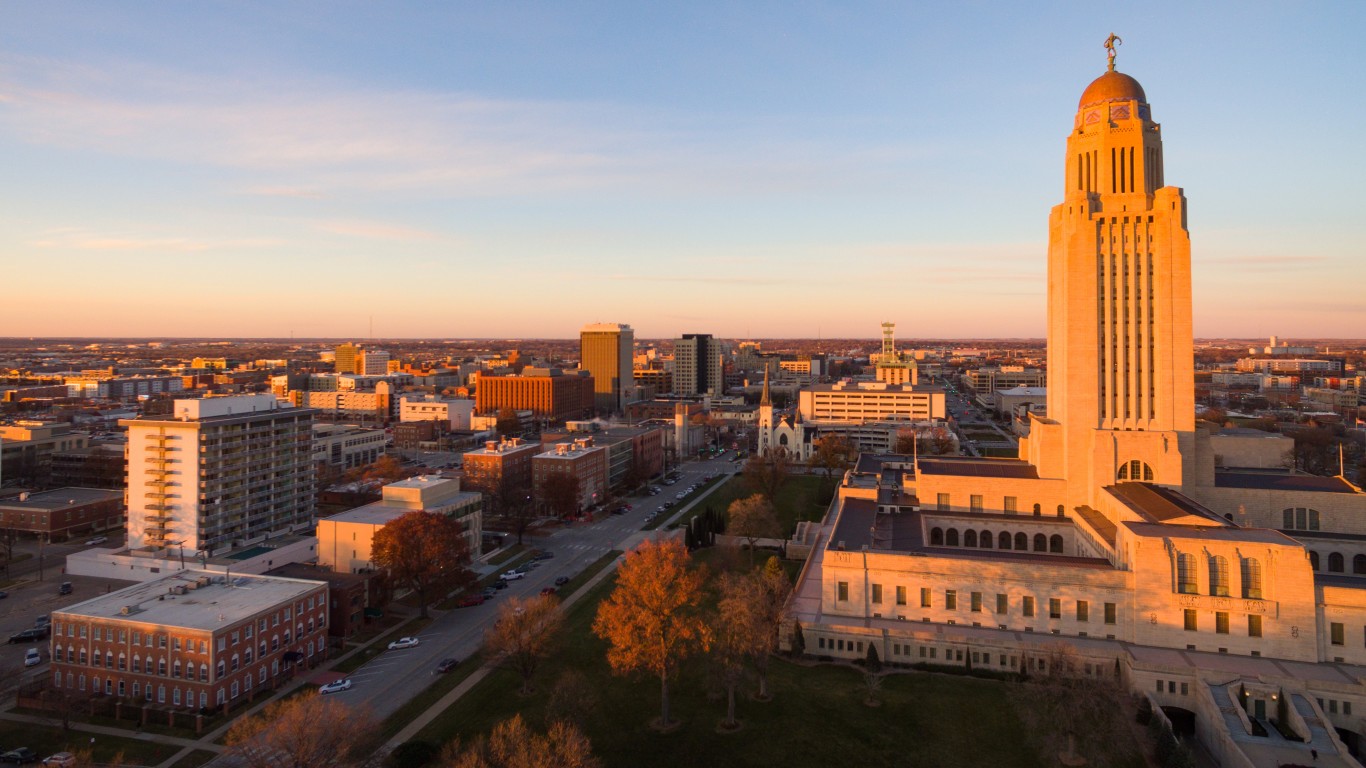
27. Nebraska
> Total population: 1,920,076 (14th lowest)
> Number of people living with cancer as of 2016: 99,460 (13th lowest)
> New cancer cases in 2019: 9,780 (14th lowest)
> Cancer deaths in 2019: 3,520 (14th lowest)
> Population with no health insurance: 8.3% (23rd highest)

28. Nevada
> Total population: 2,998,039 (18th lowest)
> Number of people living with cancer as of 2016: 120,200 (17th lowest)
> New cancer cases in 2019: 14,810 (17th lowest)
> Cancer deaths in 2019: 5,390 (17th lowest)
> Population with no health insurance: 11.2% (8th highest)

29. New Hampshire
> Total population: 1,342,795 (10th lowest)
> Number of people living with cancer as of 2016: 76,990 (10th lowest)
> New cancer cases in 2019: 8,610 (11th lowest)
> Cancer deaths in 2019: 2,820 (10th lowest)
> Population with no health insurance: 5.8% (14th lowest)
[in-text-ad-2]

30. New Jersey
> Total population: 9,005,644 (11th highest)
> Number of people living with cancer as of 2016: 504,050 (8th highest)
> New cancer cases in 2019: 53,400 (10th highest)
> Cancer deaths in 2019: 15,860 (11th highest)
> Population with no health insurance: 7.7% (24th lowest)
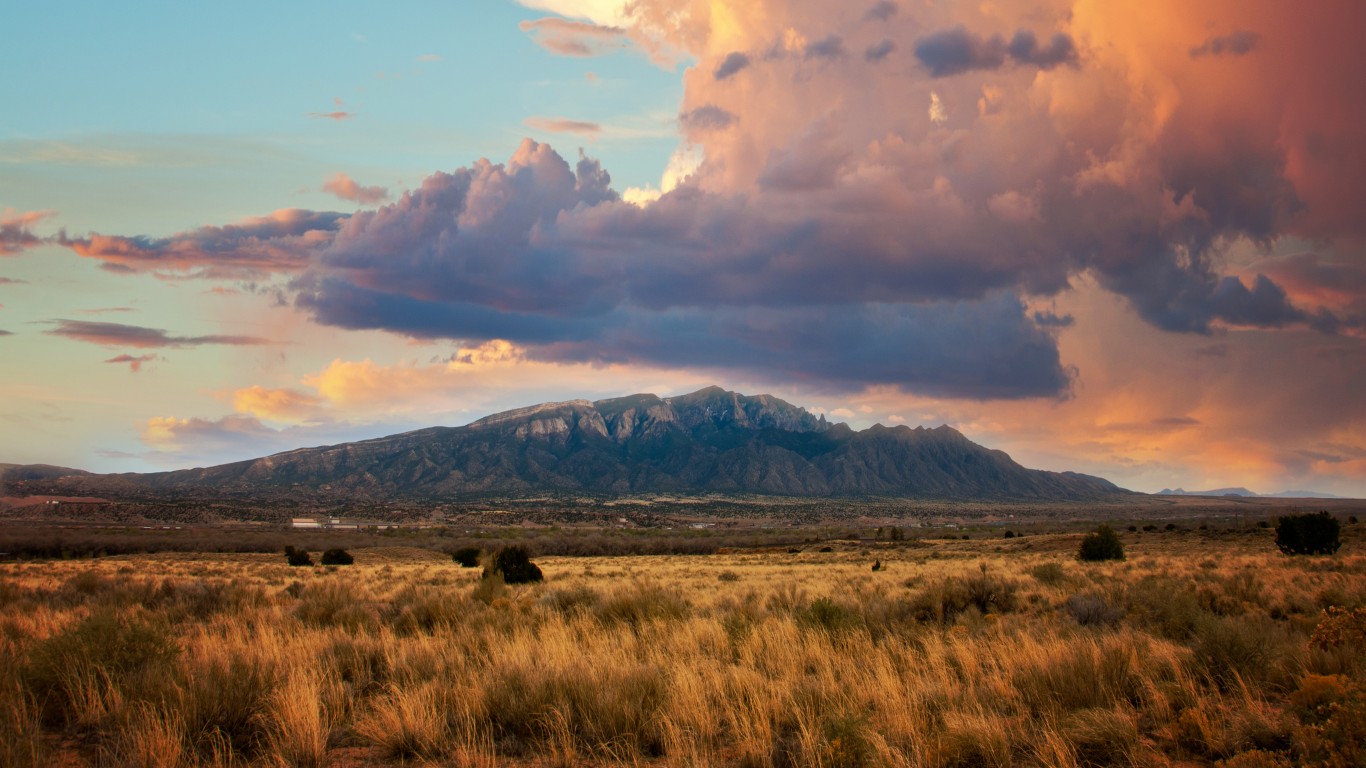
31. New Mexico
> Total population: 2,088,070 (15th lowest)
> Number of people living with cancer as of 2016: 102,100 (14th lowest)
> New cancer cases in 2019: 9,460 (13th lowest)
> Cancer deaths in 2019: 3,720 (15th lowest)
> Population with no health insurance: 9.1% (16th highest)
[in-text-ad]

32. New York
> Total population: 19,849,399 (4th highest)
> Number of people living with cancer as of 2016: 1,029,090 (3rd highest)
> New cancer cases in 2019: 111,870 (4th highest)
> Cancer deaths in 2019: 35,010 (4th highest)
> Population with no health insurance: 5.7% (13th lowest)

33. North Carolina
> Total population: 10,273,419 (9th highest)
> Number of people living with cancer as of 2016: 428,800 (9th highest)
> New cancer cases in 2019: 58,690 (8th highest)
> Cancer deaths in 2019: 20,410 (9th highest)
> Population with no health insurance: 10.7% (10th highest)

34. North Dakota
> Total population: 755,393 (4th lowest)
> Number of people living with cancer as of 2016: 35,390 (4th lowest)
> New cancer cases in 2019: 3,940 (4th lowest)
> Cancer deaths in 2019: 1,280 (3rd lowest)
> Population with no health insurance: 7.5% (23rd lowest)
[in-text-ad-2]

35. Ohio
> Total population: 11,658,609 (7th highest)
> Number of people living with cancer as of 2016: 536,430 (6th highest)
> New cancer cases in 2019: 67,150 (7th highest)
> Cancer deaths in 2019: 25,440 (6th highest)
> Population with no health insurance: 6.0% (15th lowest)

36. Oklahoma
> Total population: 3,930,864 (23rd lowest)
> Number of people living with cancer as of 2016: 189,540 (22nd lowest)
> New cancer cases in 2019: 20,540 (22nd lowest)
> Cancer deaths in 2019: 8,420 (25th lowest)
> Population with no health insurance: 14.2% (2nd highest)
[in-text-ad]

37. Oregon
> Total population: 4,142,776 (24th lowest)
> Number of people living with cancer as of 2016: 195,790 (23rd lowest)
> New cancer cases in 2019: 23,320 (24th lowest)
> Cancer deaths in 2019: 8,270 (24th lowest)
> Population with no health insurance: 6.8% (20th lowest)

38. Pennsylvania
> Total population: 12,805,537 (5th highest)
> Number of people living with cancer as of 2016: 711,240 (4th highest)
> New cancer cases in 2019: 79,890 (5th highest)
> Cancer deaths in 2019: 28,170 (5th highest)
> Population with no health insurance: 5.5% (12th lowest)

39. Rhode Island
> Total population: 1,059,639 (8th lowest)
> Number of people living with cancer as of 2016: 62,770 (8th lowest)
> New cancer cases in 2019: 6,540 (8th lowest)
> Cancer deaths in 2019: 2,140 (8th lowest)
> Population with no health insurance: 4.6% (5th lowest)
[in-text-ad-2]

40. South Carolina
> Total population: 5,024,369 (23rd highest)
> Number of people living with cancer as of 2016: 255,110 (21st highest)
> New cancer cases in 2019: 29,830 (22nd highest)
> Cancer deaths in 2019: 10,720 (21st highest)
> Population with no health insurance: 11.0% (9th highest)

41. South Dakota
> Total population: 869,666 (5th lowest)
> Number of people living with cancer as of 2016: 39,330 (5th lowest)
> New cancer cases in 2019: 4,770 (5th lowest)
> Cancer deaths in 2019: 1,680 (5th lowest)
> Population with no health insurance: 9.1% (16th highest)
[in-text-ad]

42. Tennessee
> Total population: 6,715,984 (16th highest)
> Number of people living with cancer as of 2016: 298,950 (16th highest)
> New cancer cases in 2019: 37,350 (16th highest)
> Cancer deaths in 2019: 14,840 (13th highest)
> Population with no health insurance: 9.5% (13th highest)

43. Texas
> Total population: 28,304,596 (2nd highest)
> Number of people living with cancer as of 2016: 1,041,750 (2nd highest)
> New cancer cases in 2019: 124,890 (3rd highest)
> Cancer deaths in 2019: 41,300 (3rd highest)
> Population with no health insurance: 17.3% (the highest)

44. Utah
> Total population: 3,101,833 (20th lowest)
> Number of people living with cancer as of 2016: 105,310 (15th lowest)
> New cancer cases in 2019: 11,620 (15th lowest)
> Cancer deaths in 2019: 3,310 (13th lowest)
> Population with no health insurance: 9.2% (15th highest)
[in-text-ad-2]

45. Vermont
> Total population: 623,657 (2nd lowest)
> Number of people living with cancer as of 2016: 31,530 (2nd lowest)
> New cancer cases in 2019: 3,920 (3rd lowest)
> Cancer deaths in 2019: 1,440 (4th lowest)
> Population with no health insurance: 4.6% (5th lowest)

46. Virginia
> Total population: 8,470,020 (12th highest)
> Number of people living with cancer as of 2016: 373,580 (12th highest)
> New cancer cases in 2019: 45,440 (12th highest)
> Cancer deaths in 2019: 15,200 (12th highest)
> Population with no health insurance: 8.8% (19th highest)
[in-text-ad]

47. Washington
> Total population: 7,405,743 (13th highest)
> Number of people living with cancer as of 2016: 352,830 (14th highest)
> New cancer cases in 2019: 39,160 (14th highest)
> Cancer deaths in 2019: 13,010 (16th highest)
> Population with no health insurance: 6.1% (18th lowest)

48. West Virginia
> Total population: 1,815,857 (13th lowest)
> Number of people living with cancer as of 2016: 107,520 (16th lowest)
> New cancer cases in 2019: 12,440 (16th lowest)
> Cancer deaths in 2019: 4,820 (16th lowest)
> Population with no health insurance: 6.1% (18th lowest)
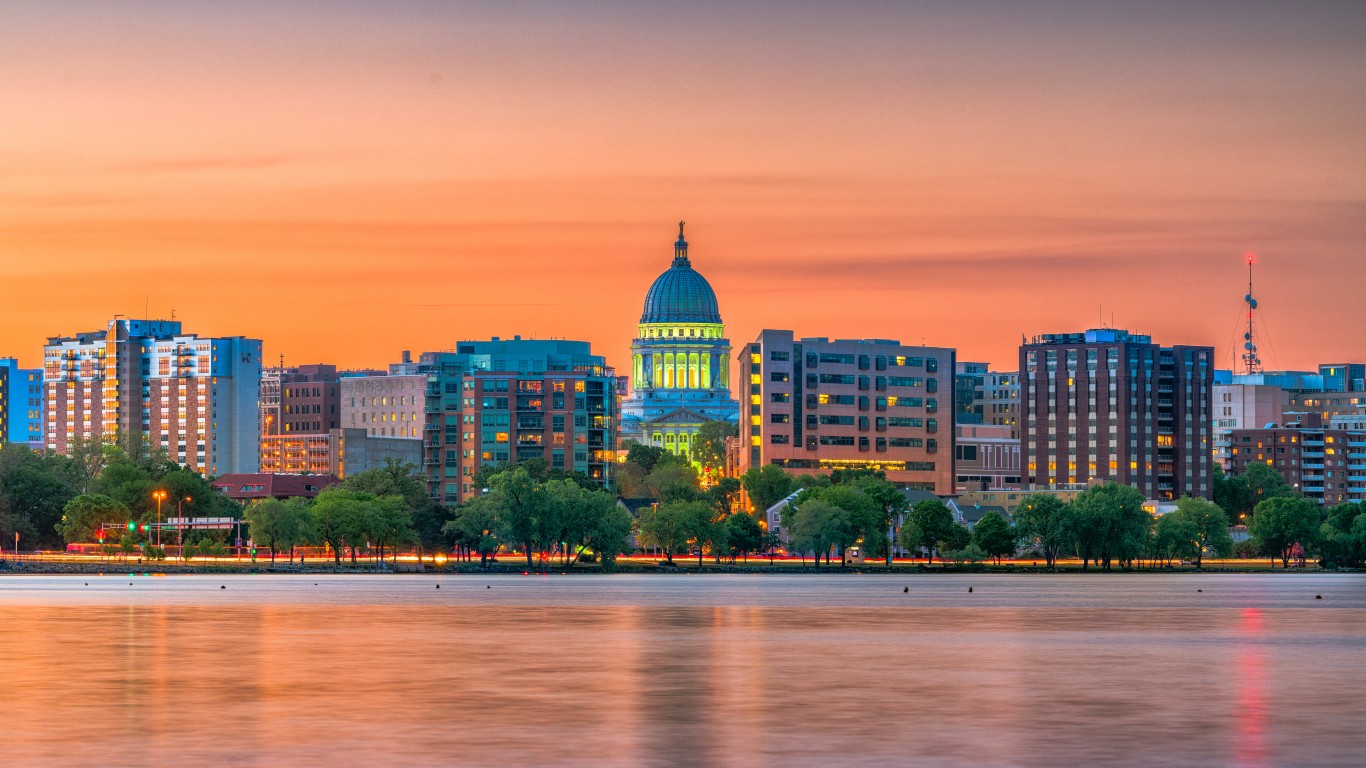
49. Wisconsin
> Total population: 5,795,483 (20th highest)
> Number of people living with cancer as of 2016: 288,410 (17th highest)
> New cancer cases in 2019: 34,220 (19th highest)
> Cancer deaths in 2019: 11,730 (19th highest)
> Population with no health insurance: 5.4% (10th lowest)
[in-text-ad-2]

50. Wyoming
> Total population: 579,315 (the lowest)
> Number of people living with cancer as of 2016: 30,370 (the lowest)
> New cancer cases in 2019: 2,930 (the lowest)
> Cancer deaths in 2019: 980 (the lowest)
> Population with no health insurance: 12.3% (6th highest)
If you’re one of the over 4 Million Americans set to retire this year, you may want to pay attention.
Finding a financial advisor who puts your interest first can be the difference between a rich retirement and barely getting by, and today it’s easier than ever. SmartAsset’s free tool matches you with up to three fiduciary financial advisors that serve your area in minutes. Each advisor has been carefully vetted, and must act in your best interests. Start your search now.
Don’t waste another minute; get started right here and help your retirement dreams become a retirement reality.
Thank you for reading! Have some feedback for us?
Contact the 24/7 Wall St. editorial team.